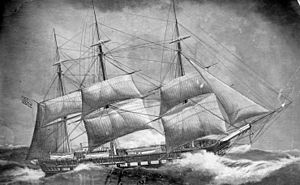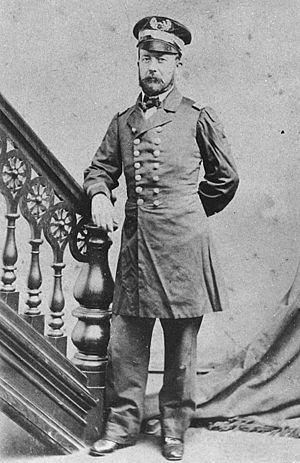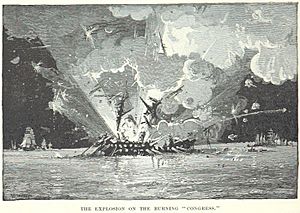USS Congress (1841) facts for kids

USS Congress (1841)
|
|
Quick facts for kids History |
|
|---|---|
| Name | USS Congress |
| Launched | August 16, 1841 at Portsmouth Naval Shipyard |
| Commissioned | May 7, 1842 |
| Stricken | 1862 (est.) |
| Fate |
|
| General characteristics | |
| Type | Frigate |
| Tonnage | 1867 |
| Length | 179 ft (55 m) (p.p.) |
| Beam | 47 ft 9.6 in (14.569 m) |
| Draft | 22 ft 6 in (6.86 m) |
| Propulsion | Sails |
| Complement | 480 officers and enlisted |
| Armament | 4 × 8 in (200 mm) guns, 48 × 32 pdr (15 kg) guns |
The USS Congress (1841) was a sailing frigate, a type of warship. She was the fourth ship in the United States Navy to be named Congress.
This ship sailed in many parts of the world, including the Mediterranean Sea, the South Atlantic Ocean, and the Pacific Ocean. She served the U.S. Navy until the American Civil War. During this war, she was sunk by the powerful ironclad ship, CSS Virginia, in a famous battle near Newport News, Virginia.
Contents
Early Voyages: Mediterranean and South Atlantic
The Congress was built at the Portsmouth Naval Shipyard and launched on August 16, 1841. She officially joined the Navy on May 7, 1842, under Captain Philip Voorhees. Her first trip began on July 15, taking her to the Mediterranean Sea. There, she joined a group of warships led by Commodores Charles W. Morgan and Charles Morris.
In December 1843, the Congress moved to the South Atlantic. She joined Commodore Daniel Turner's group of ships, known as the Brazil Squadron. Their job was to protect U.S. trade during the Uruguayan Civil War. On September 29, 1844, Captain Voorhees captured an Argentine ship that was delivering mail. This caused problems between the U.S. and Argentina. Captain Voorhees faced a military trial for his actions, but it did not stop his career for long.
The Congress stayed in this area until January 1845. After that, she was taken out of active service for a while in Norfolk, Virginia.
Serving in the Mexican–American War
The Congress was put back into service on September 15, 1845. She became the main ship, or flagship, for Commodore Robert F. Stockton. In late October, she sailed for the Pacific Ocean. She dropped off a U.S. official in Honolulu, Hawaii on June 10. Then, she sailed to Monterey Bay to join the Pacific Squadron.
Captain Elie A. F. La Vallette took command on July 20. He used the ship along the west coast during the Mexican–American War. Many sailors from the Congress fought on land. They took part in battles like the Battle of Rio San Gabriel and the Battle of La Mesa. They also helped take control of Los Angeles.
In October 1847, the Congress helped attack and capture Guaymas. In November, some of her crew helped take control of Mazatlán. On August 23, 1848, she left La Paz, Baja California Sur. She arrived in Norfolk, Virginia, the next January and was again taken out of active service.
Fighting the Slave Trade
In May 1850, the Congress was given three important jobs. First, she had to protect U.S. interests between the Amazon River and Cape Horn. Second, she needed to stop ships from using the American flag to hide the African slave trade. Third, she had to make sure the U.S. stayed neutral during conflicts between South American countries.
She left Hampton Roads, Virginia, on June 12. On September 1, she arrived in Rio de Janeiro, Brazil. There, she served as the flagship for Commodore Issac McKeever until June 1853. She then returned to New York City on July 20 and was taken out of service.
More Mediterranean Missions
On June 19, 1855, the Congress sailed back to the Mediterranean Sea. For two years, she was the flagship for Commodore Samuel Livingston Breese. She left Spezia, Italy, on November 26, 1857. She arrived in Philadelphia, Pennsylvania, on January 13, 1858, and was again taken out of service.
In 1859, the Congress became the flagship for Commodore Joshua R. Sands and the Brazil Squadron once more. She stayed in that area until the start of the Civil War. This war caused her to return to Boston, Massachusetts, on August 22, 1861.
American Civil War Service and Final Battle
On September 9, 1861, the Congress was ordered to join the Atlantic Blockading Squadron. She served under Captain Louis M. Goldsborough, then under Commander W. Smith, and later under executive officer Lieutenant Joseph B. Smith.
On March 8, 1862, the Congress was anchored near Newport News, Virginia. She was part of the Union blockade trying to stop ships from entering or leaving the port. That day, she was attacked by the Confederate ironclad ship, CSS Virginia (which used to be the USS Merrimack). Five smaller Confederate ships also joined the attack.
During the battle, McKean Buchanan was serving on the Congress. His brother, Franklin Buchanan, was the commanding officer of the Virginia. The Congress and Virginia exchanged cannon fire. The Congress then slipped her anchors and got stuck in shallow water.
The ironclad and its partner ships attacked from a distance. They caused a lot of damage to the Congress. About 120 sailors were killed, including the commanding officer, Joseph B. Smith. Executive officer Austin Pendergrast took command. The Congress was on fire in several places. She could not aim her guns at the enemy. She was forced to surrender and raised a white flag.
However, strong cannons on the shore prevented the Virginia from taking over the Congress. Instead, the Virginia fired hot cannonballs and incendiary (fire-starting) shots. This caused the Congress to burn down to the waterline. Eventually, her magazine (where gunpowder was stored) exploded. Lieutenant Smith, who was in command at the time, died in the battle. The Congress slowly sank by her stern (the back of the ship).
After the Battle
In September 1865, the remains of the Congress were pulled up from the water. She was taken to the Norfolk Navy Yard and later sold. Her valuable wood and metal were removed. The ship's sails were even used to make a flag to remember the ship.
Images for kids
See also
 In Spanish: USS Congress (1842) para niños
In Spanish: USS Congress (1842) para niños





